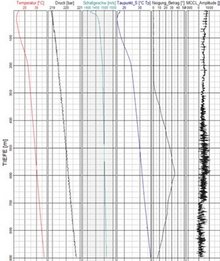Report from project partner SOCON: First measurements in hydrogen successfully carried out


In the hydrogen caverns existing worldwide (Great Britain and USA), direct measurements in hydrogen have never been carried out so far. Typically, only logging has been carried out in the brine-filled inner string or cavity measurement with ultrasound in the cavern completely flooded with brine. Various projects and research projects for the storage of hydrogen are currently underway, but the deployment in the context of the tests on the Zuidwending ZWA8A cavern of N.V. Nederlandse Gasunie is the first real deployment of borehole probes in a hydrogen-filled borehole.
In September 2021, ultrasonic probes were thus inserted directly into a hydrogen-filled well for the first time. Extensive preliminary investigations had of course been carried out in advance with regard to the suitability of the materials to be used. The entire airlock technology was tested at Hartmann Valves in Celle at the beginning of the year.
The materials from which the ultrasonic probes (SoMIT sonde and BSF2) are made were found to be suitable in advance.
For the measurement under hydrogen that has now taken place (September 2021), the primary interest was to carry out a leak test with the SoMIT method in order to prove that this method can also be used safely and with the required accuracy in hydrogen-filled boreholes. However, additional tests with a BSF2 echo probe were also to be carried out in order to obtain initial findings on the use of an echo probe.
All SOCON employees involved in the operation received special instruction in advance on the subject of "Special features of work on hydrogen-filled caverns" in order to be as well prepared as possible for the conditions that differ from those of a survey on caverns filled with natural gas (larger area for an explosive mixture, greater danger due to possible static charge caused by hydrogen flowing past, etc.).
The main results of the SoMIT test are:
- The method can also be used under hydrogen.
- The probe is fully functional in hydrogen.
- The coupling of the emitted ultrasonic signal to the medium hydrogen is better than to nitrogen.
- The achievable ranges are greater and the attenuation of the emitted ultrasonic signal is lower than in nitrogen.
The main results of the BSF2 test can be summarised as follows:
- The echo probe is fully functional in hydrogen.
- The sound velocity (measured with the BSF2 sound velocity measurement section) is considerably higher than in nitrogen or natural gas.
- The dew point could be measured, so that the moisture content could be calculated.
- Compared to natural gas, other measurement frequencies were required.
- Extremely large ranges could be achieved for ultrasound measurements in hydrogen, confirming the results that had already been determined with the SoMIT probe.
After the measurements, both the sondes used and test pieces of the measuring cable are examined in detail. In the case of the measuring cable, the focus of the investigations is on possible structural changes and the effect on ductility, among other things. The probes are completely disassembled and all components are examined for possible effects or damage.
The results of these investigations were presented at a Socon customer seminar.
In conclusion, SOCON is very well positioned with its measurement technology to meet the challenges for tightness tests and for echometric measurements in hydrogen-filled boreholes and caverns. The first results have shown that the path taken with the technology used is the right one.
Source: ECHONews SOCON September 2021
Frank Haßelkus